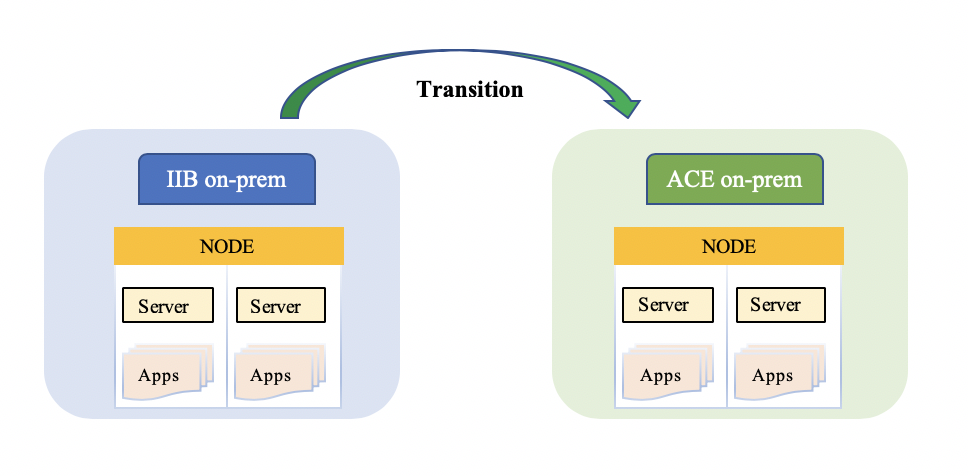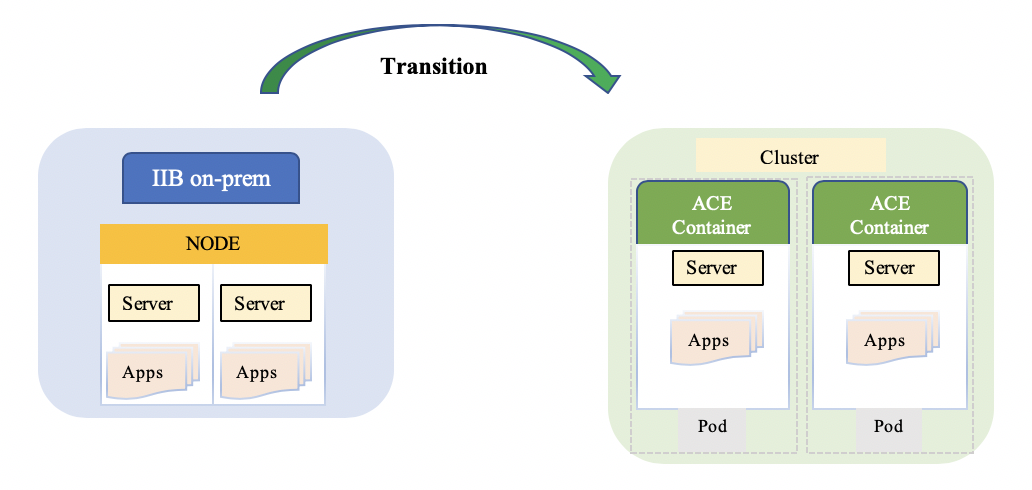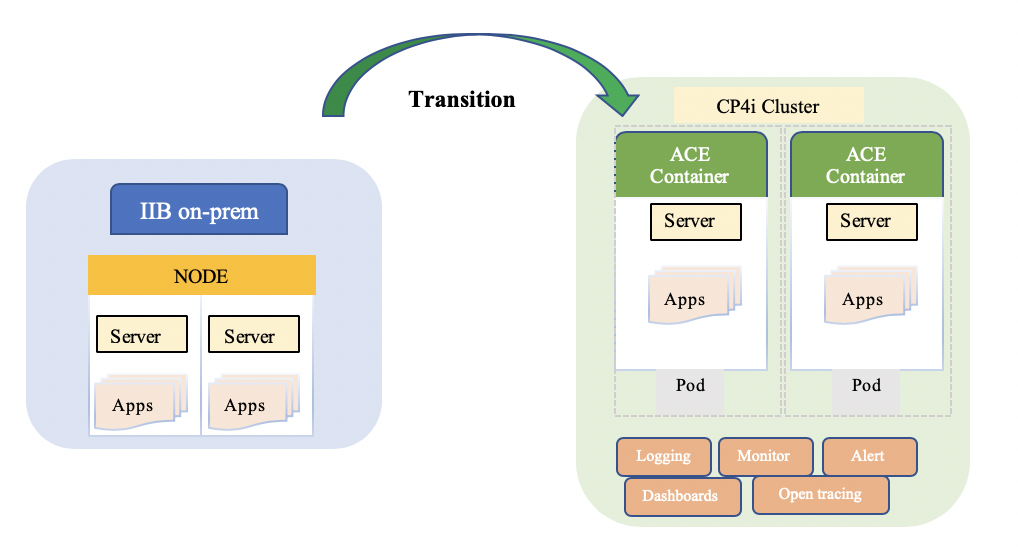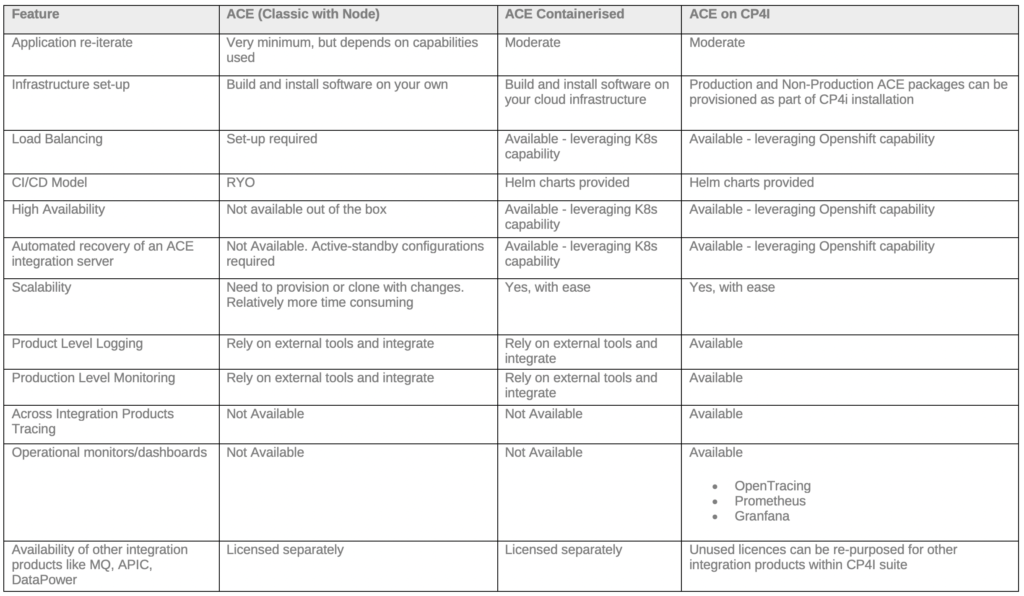
Transitioning from IIB to ACE – Considerations and Options
IBM App Connect Enterprise (ACE) has been out for more than two years and provides capabilities on implementing and modernising your applications to meet your current business needs. Like previous versions, it supports a wide range of integration styles, from traditional SOA to the more modern events, APIs, and microservices.
This blog shows you the options for migrating from IIB to ACE and the new deployment options available within ACE.
WHAT HAS CHANGED?
Before you start, you should be mindful of the key changes/enhancements to the product. These should be taken into consideration as part of the assessment phase.
- Currently supported on Windows, Linux and AIX platforms only;
- Stand-alone integration server can be run without a node configuration;
- Configurable services are deprecated but introduced XML based policy files as an alternative;
- Several message flow level nodes have been retired. For example, DataDelete, DataInsert, DataUpdate, MQOptimizedFlow;
- Enhanced cloud support;
- Improved integration with monitoring and logging tools like ELK (Elastic Stack).
WHAT ARE THE MIGRATION PATHS?
ACE supports the extract migration and parallel migration approaches to uplift your applications. There are a number of IBM videos and articles that cover these topics extensively (links are available at the end of this blog). We have provided a brief summary below.
1. EXTRACT MIGRATION
The extract migration method recreates configurations and resources of IIB into the ACE system using the IBM provided “mqsiextractcomponents” command.
You can extract the following resources and configurations:
- Integration node, including all integration servers associated with it or
- Individual integration servers
2. PARALLEL MIGRATION
Using parallel migration, you are creating a new version of your ACE integration node (with integration servers associated or standalone ACE integration servers) to run in parallel with your existing IIB node.
The method involves the following steps:
- Import your existing applications into the ACE toolkit to analyse compatibility
- Redesign your flows, if necessary
- Run the IBM Transformation Advisor tool (if you plan to run ACE in a container). Check for any compatibility issues and the recommended solutions here
- Create policies as an alternative for your existing configurable services
- Build the bars
- Deploy to an ACE supported platform
MIGRATION LIMITATIONS
You can migrate from IBM Integration Bus Version 10.0 or 9.0 only to IBM App Connect Enterprise Version 11.0. IBM App Connect Enterprise Version 11.0 can be either the full edition or the standard edition.
It is not recommended to migrate integration nodes from an earlier version to the Developer Edition.
WHAT ARE THE DEPLOYMENT OPTIONS?
There are three deployment options in ACE.
- ACE (Classic with Node)
- ACE Containerised
- ACE on Cloud Pak for Integration
The option you choose will determine your migration path. Below are the possible combinations.

BM has provided the Transformation Advisor (TA) Tool that can help determine the remeditaion steps required when migrating. The TA tool can be found here
1. ACE (CLASSIC WITH NODE)
This is a suitable option if you are planning to migrate from on-premise to on-premise. The target state comprises of integration node/s with associated integration servers to achieve backward compatibility. This may involve updating your existing deployment and operational procedures.

2. ACE CONTAINERISED
With the ability to run stand-alone ACE integration servers, you can now package applications and run them in containers on a cloud or an on-premise Kubernetes cluster (like Red Hat Openshift). Doing so gains you out of the box benefits of a cluster environment such as high-availability, self-recovery and load balancing. This change may require a logical separation of applications, based on your application interfaces, business units or organisation divisions. For example, all customer APIs or services grouped into one container and card APIs and services into another.
There is an additional step for ACE containerisation where built application bars are baked into an IBM certified ACE image before pushing it to cluster for a deployment. The target state includes ACE container/s running inside a Pod of a cluster.

3. ACE ON CLOUD PAK FOR INTEGRATION
By now you must be aware of IBM’s new all-in-one integration platform called Cloud Pak for Integration (CP4I). If not, please, read our previous blogs here to understand more about the features and benefits of the new product.
The deployment approach, in this scenario, is very similar to option 2. However, CP4I running on Red Hat Openshift provides a robust way of managing your runtime containers with built-in monitoring, logging, tracing and operational dashboard capabilities. You can integrate with other CP4I components such as MQ, API Connect seamlessly. The IBM provided helm charts can be utilised to automate pipelines achieving your CI/CD goal.

WHAT ARE THE PACKAGING OPTIONS?
The following packaging options are applicable if you are containerising your ACE runtime in a container-based cluster or in a CP4I environment.
- Ace-only: Container image with stand-alone ACE runtime
- Ace-mqclient: Container docker with stand-alone ACE runtime along with mqclient libraries to connect to an external MQ Server
- Ace-mqserver: Container image with stand-alone ACE runtime and MQ Server
The above deployment options are for ace-only containers. However, we will be publishing blogs on scenarios with ace-mqclient and ace-mqserver containers shortly.
ACE FEATURES

IN CONCLUSION
The new version of ACE appears to have all the capabilities and features to modernise your integration solutions as summarised above. Syntegrity has the expertise and is here to help and guide you through the migrating phase. Please reach out to us for workshops or questions if you have any.
WHERE CAN I FIND MORE INFORMATION?
- IBM Developer article on IIB to ACE migration
- IBM IIB to ACE Migration YouTube video
- IBM IIB to ACE Migration Webcast
- IIB to ACE Compatibility Rules applied by the TA tool
- New features on ACE latest version
- IBM ACE Tutorials and Blogs
- Syntegrity blogs on IBM Cloud Pak for Integration
- IBM ACE Documentation
- IBM Cloud Pak for Integration Documentation